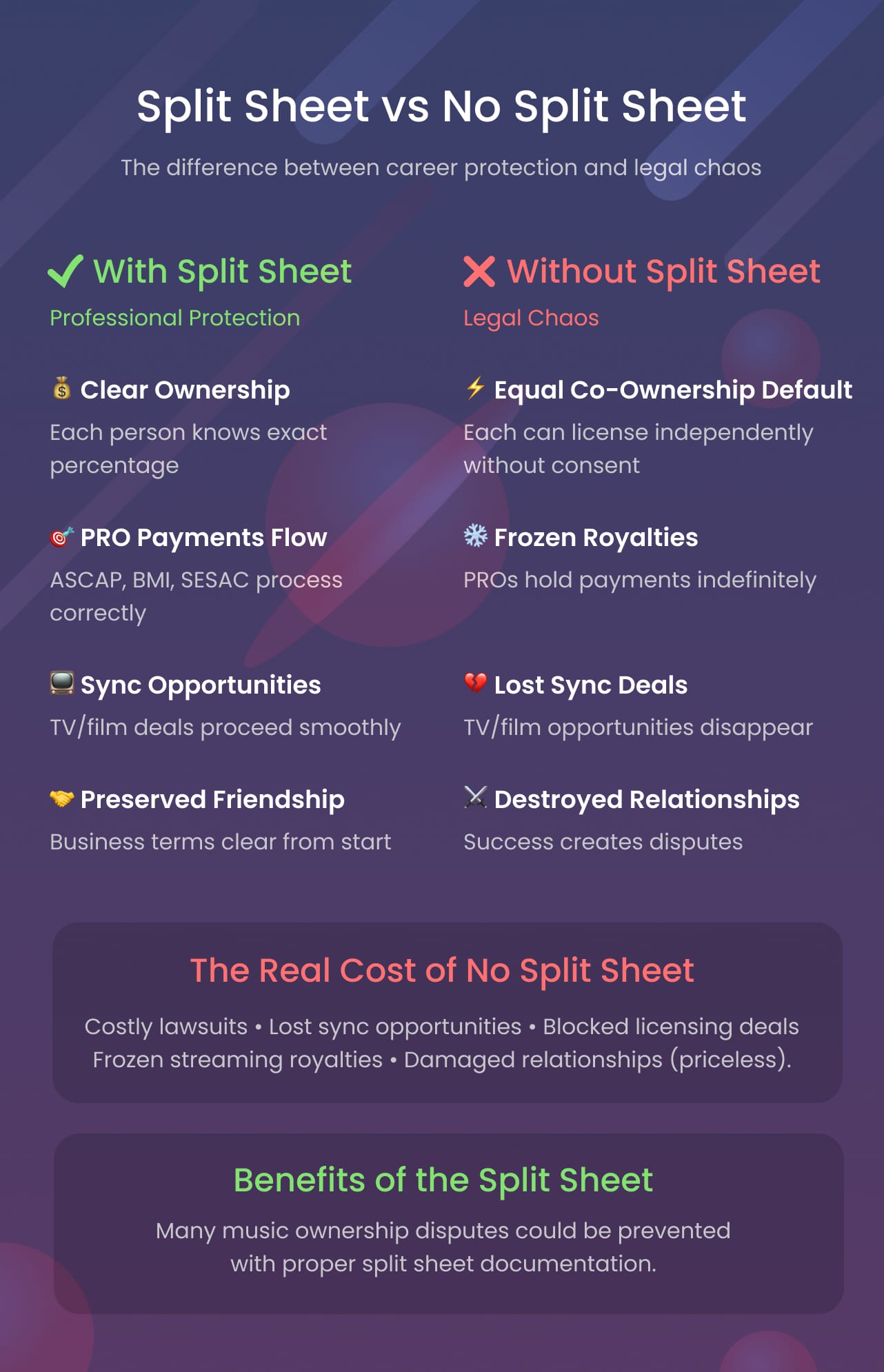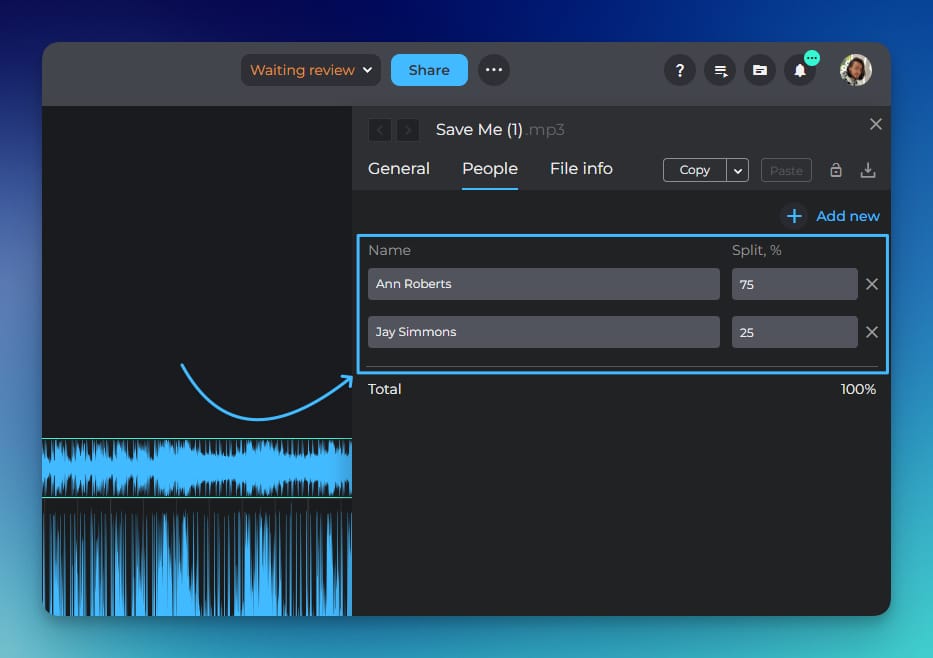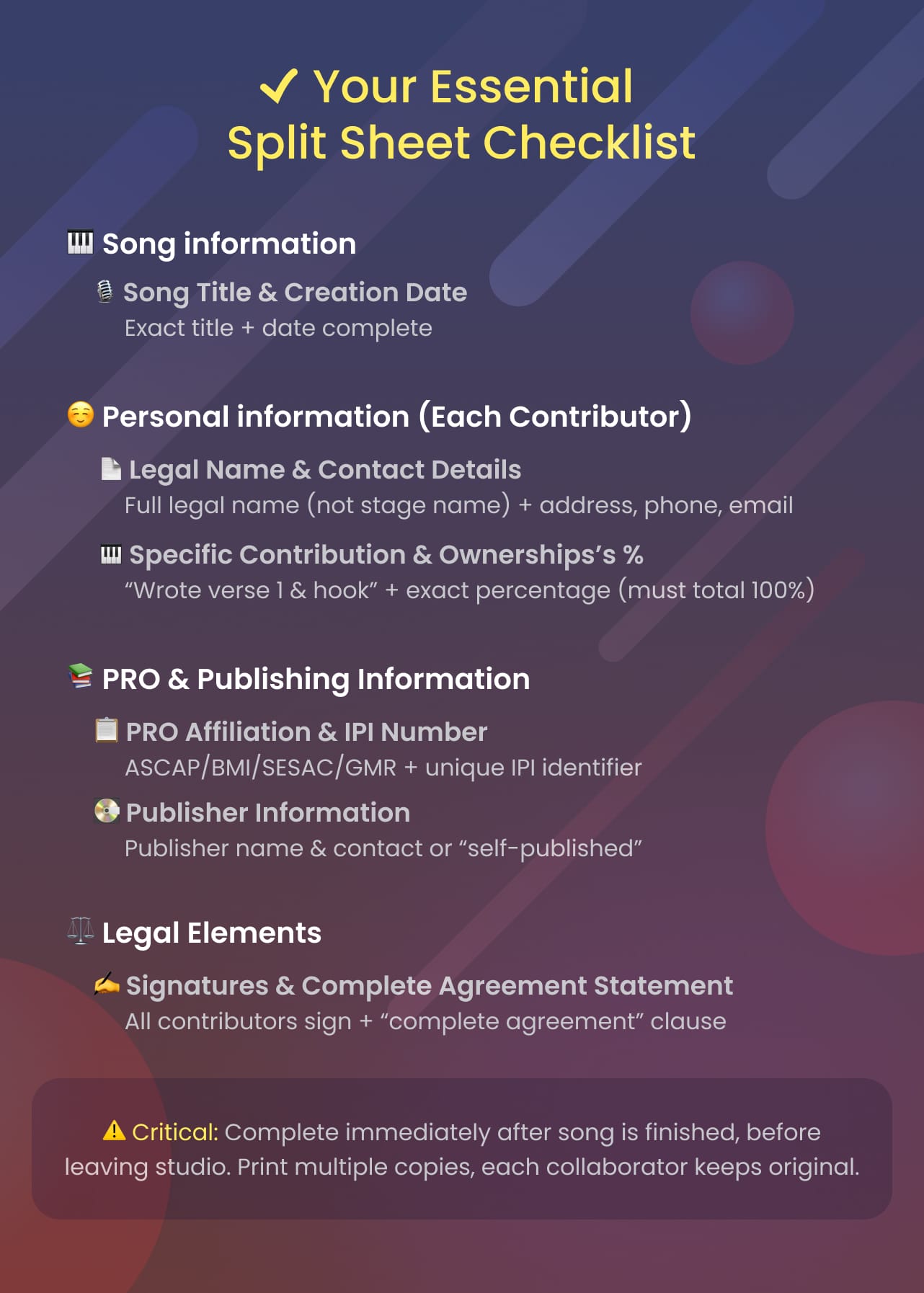A split sheet is a written agreement that identifies each contributor to a song and establishes ownership percentages among them. Think of it as a receipt for creativity: it documents who brought what to the table and how much of the pie each person gets when the money starts rolling in. A split sheet could be the difference between buying your mom a house and paying a lawyer's mortgage instead.
What makes split sheets different from other music agreements? While a recording contract deals with the actual recording, and a collaboration agreement might cover broader terms, a split sheet focuses specifically on ownership of the musical composition and master recording.
Getting a track featured at the NBA All-Star Game is an incredible feeling, and it’s the kind of success I work towards with every artist as Luke Mounthill. But I've also learned that without the right legal foundation, even the biggest wins can be put at risk. This guide is about securing those wins before it's too late.
TL;DR: Why you need a split sheet (seriously)
Without a split sheet, everyone involved in a song's creation technically owns 100% of the song, which leads to chaos, lost royalties, and missed deals. A split sheet protects your income, your friendships, and your future opportunities.
- What it is: A legal document that defines who owns what percentage of a song
- Why it's crucial: Without one, U.S. copyright law defaults to a chaotic co-ownership model, and PROs can't pay you.
- When to make it: Immediately after the song is finished, before leaving the studio
- What it needs: Legal names, PRO info, specific contributions, and ownership percentages totaling 100%
Creators should spend more time making music, not chasing paperwork. With Pibox, it’s easy to embed split-sheet info directly into your audio file’s metadata, keeping your legal details attached to your tracks automatically. Use Pibox and stay focused on what matters: your music.
Why should you care about split sheets?
The absence of a split sheet creates a dangerous default under U.S. copyright law. Without written documentation, every collaborator automatically owns 100% of the song. Yes, you read that right. Each person involved has full control to license, distribute, and profit from the work without consulting others.
This legal chaos becomes real when opportunities arise. I've seen sync deals worth thousands fall apart because one collaborator couldn't be reached. Record labels have shelved potential hits because ownership wasn't clear. Streaming platforms have frozen royalty payments while creators fought over percentages.

How to modernize your split-sheet workflow
A signed split sheet is a huge step, but it has one major flaw: it's a separate document. It lives in an email, a Dropbox folder, or as a crumpled piece of paper in a studio. The actual master WAV or MP3 file has no connection to this critical legal agreement, which can lead to confusion and disputes years later.
But what if the song file itself could be the source of truth? What if the ownership information traveled with the music, accessible to anyone who needed to verify it?
This is where a modern collaboration platform like Pibox changes the game. After you've agreed on the percentages with your collaborators, Pibox allows you to directly edit the audio metadata of the master file. This means you can embed the songwriter and publisher information—the names and percentage splits—right into the digital DNA of the track.

By doing this, the song file becomes a secure container for its own business information. There's no more searching for lost PDFs or debating who owns what. The credits and splits are attached to the music, making the process of registering with PROs like ASCAP or BMI and collecting royalties much more streamlined and error-proof. It's the professional standard for the modern music industry.
Pibox is the easier, faster way to collaborate in real-time, collect feedback, manage reviews, share, and finish your projects effortlessly.
How does a split sheet protect your friendships?
Money changes relationships, especially when success arrives unexpectedly. A split sheet removes emotion from business decisions by establishing terms when everyone's thinking clearly. You're not arguing about percentages after a song blows up. You're simply following the agreement you made as friends.
What happens to royalties without proper documentation?
Performance rights organizations (PROs) like ASCAP and BMI cannot process incomplete registrations. Without clear ownership documentation, they hold your money indefinitely. Music publishers won't touch songs with unclear splits. Sync licensing opportunities disappear. Your potential income sits in limbo while lawyers get rich sorting out the mess.
The main parts of a split sheet
A professional split sheet captures specific information that PROs, publishers, and courts recognize as legally binding. Missing even one element can invalidate the entire document.
1. What personal information must you include?
Start with every contributor's legal name, not stage names or nicknames. Include current mailing addresses, phone numbers, and email addresses. This information helps track down collaborators years later when opportunities arise. Add each writer's PRO affiliation (ASCAP, BMI, SESAC, or GMR) and their IPI number (the unique identifier assigned by their PRO).
2. How do you document creative contributions?
List each person's specific contribution: songwriter (lyrics), composer (music), or both. Some split sheets include producer credits separately from composition. Be specific about who created what. For example, "wrote verse 1 and hook" provides more clarity than just "songwriter."
3. What about percentage splits and publishing information?
The percentages must total exactly 100%. Document both the writer's share and publisher's share if applicable. If someone has a publishing deal, include their publisher's name and contact information. Self-published writers should note "self-published" or their company name if they've established one.
4. How do musicians decide what percentage each contributor gets?
Song splits can vary widely, but here’s a practical example from hip-hop sessions: lead artists often take 40–50%, feature artists 10–25%, producers 20–50%, and engineers 5–10%. The key rule is that everything must add up to 100%, since that’s what determines how royalties are divided. There’s no universal law, just norms. That’s why many pros use split sheets right after a session, so no one forgets who contributed what.
Your essential split sheet checklist
Here's exactly what every split sheet must include to be legally valid and professionally acceptable:
Song information:
- Song title
- Date of creation
- Recording location (optional but helpful)
For each contributor:
- Legal name (not stage name)
- Role (songwriter/composer/producer)
- Specific contribution (lyrics/music/both)
- Contact info (address, phone, email)
- PRO affiliation (ASCAP/BMI/SESAC/GMR)
- IPI number
- Publisher information (if applicable)
- Ownership percentage (must total 100%)
Legal elements:
- Statement that this represents the complete agreement
- Signature line for each contributor
- Date of signature
- Witness signatures (optional but recommended)
Print multiple copies; each collaborator keeps an original. Store digital copies in multiple locations. This simple checklist has saved countless artists from expensive legal battles.

How to use split sheets on your music
Timing matters as much as the document itself. The music industry moves fast, and verbal agreements evaporate even faster when success arrives.
1. When is the perfect time to create a split sheet?
Complete your split sheet immediately after finishing the song, ideally before leaving the studio. This way, creative contributions remain fresh in everyone's memory, and the collaborative spirit still flows, making percentage discussions easier. Some producers keep blank split sheets in their studios for this exact moment.
2. How do you bring up split sheets without killing the vibe?
Frame the conversation as protecting everyone's interests, not preparing for conflict. Start with enthusiasm about the song's potential: "This track is fire! Let's make sure we're all protected when it blows up." Keep blank split sheets visible in your studio as a normal part of the process. Professional collaborators expect and appreciate proper documentation.
3. What common split-sheet mistakes destroy songs?
The biggest mistake is waiting too long. Memories fade, relationships change, and what seemed obvious becomes debatable. Other critical errors include using nicknames instead of legal names, forgetting to include all contributors (even minor ones), and accepting verbal agreements over written documentation.
Never sign a blank split sheet or one with percentages you'll "figure out later." Those placeholders become permanent when someone disappears or changes their mind. Get everyone's signature on the same day; digital signatures through DocuSign or similar services count as legally binding.
FAQ
Do I need a split sheet if I work alone?
No, split sheets are only necessary when multiple people collaborate on a song. Solo creators automatically own 100% of their work. However, if you hire session musicians or featured artists, you might need agreements clarifying their role as performers versus creators.
What's the difference between a split sheet and a collaboration agreement?
A split sheet documents ownership percentages for a specific song. A collaboration agreement covers broader terms like who has admin rights, how decisions get made, and how money gets distributed. Think of split sheets as receipts and collaboration agreements as business partnerships.
Can I change split percentages after signing?
Technically yes, if all parties agree in writing. Practically, it's extremely difficult. Success makes people less willing to give up percentages. Always negotiate splits fairly from the beginning rather than promising to "fix it later."
Should producers always get publishing splits?
This depends on the producer's contribution. Producers who only provide beats typically get paid upfront or through master royalties. Those who contribute to songwriting, such as by suggesting lyrics, creating melodies, or arranging music, deserve publishing splits. Have this conversation before recording begins.
Do I need a lawyer to create a valid split sheet?
Basic split sheets don't require lawyers if you use established templates and everyone agrees on the terms. However, complex situations involving samples, multiple publishers, or unusual arrangements benefit from legal review. When in doubt, a few hundred dollars for legal advice beats thousands in litigation costs.
Wrapping up: Protect what you create
Split sheets may be simple agreements, but they play a massive role in protecting your music, your money, and your creative relationships. They define who owns what percentage of a song based on actual contributions, and without one, you risk losing royalties, sync deals, or label interest due to unclear ownership.
Understanding and using split sheets transforms you from a rookie hoping things work out to a professional building a sustainable music career. The five minutes it takes to document ownership now can save you years of legal headaches down the road.
With Pibox, you can make this process effortless. Beyond file sharing and feedback, Pibox lets you embed ownership info directly into your audio metadata, store split sheets and track versions, and keep everything organized and accessible for everyone involved.
Don’t just finish the track. Protect it. Use Pibox to secure your rights and stay focused on making music.
Easier, faster way to collaborate in real-time, collect feedback, manage reviews, share, and finish your projects effortlessly.










